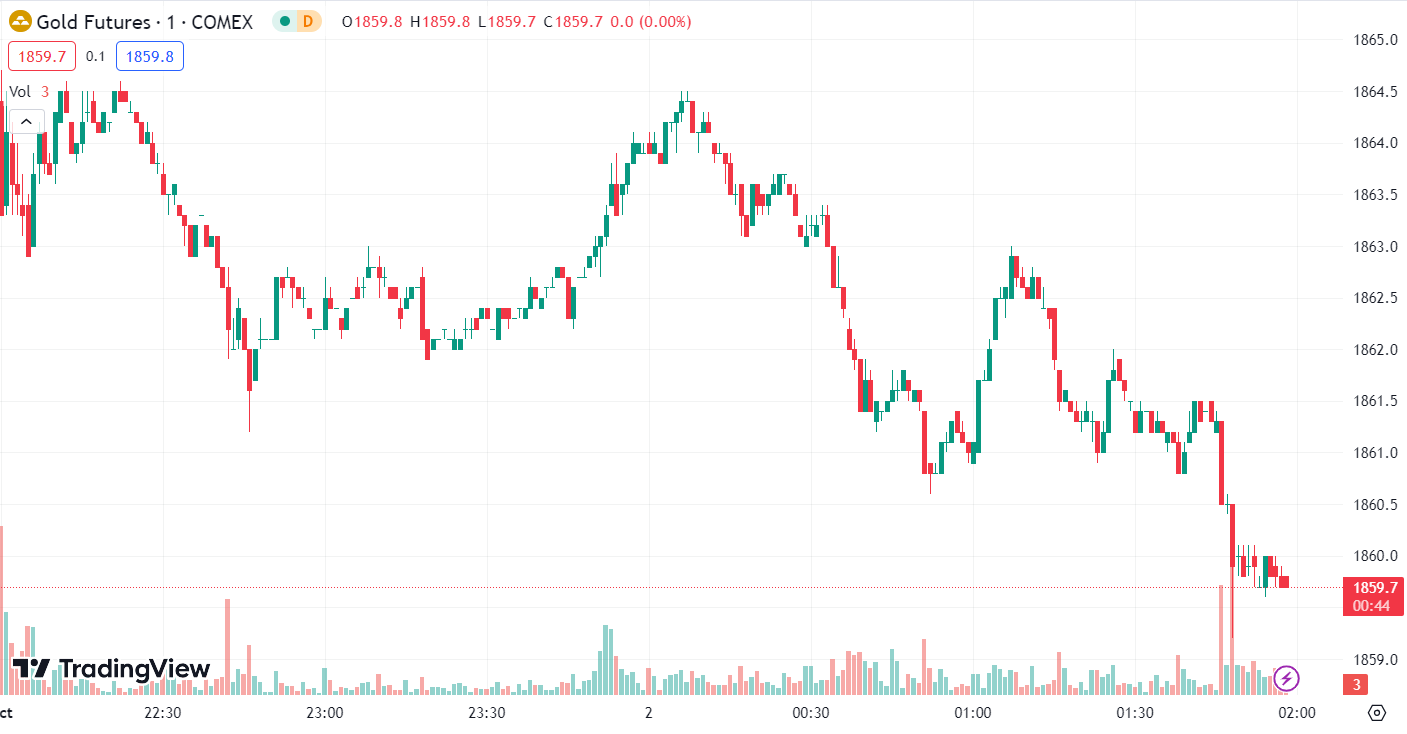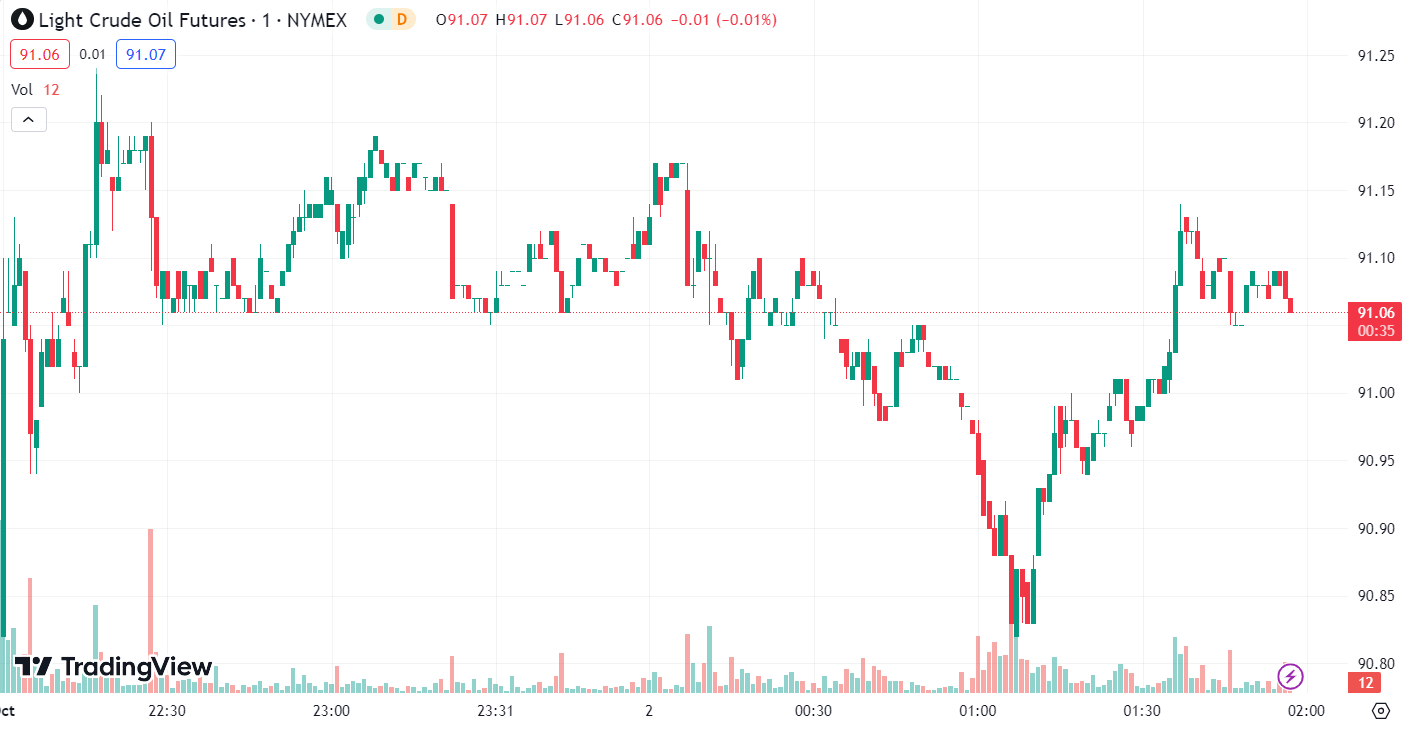
The increase in interest rates in the United States has strengthened the US dollar and pushed up US Treasury yields, reducing the attractiveness of gold.
As a result, gold prices have dropped by nearly 4%. The market anticipates that major central banks will maintain high-interest rates to combat stubborn inflation, which has led to a slight decline in oil prices after earlier gains.
Gold>>
Last Friday, during the U.S. market’s closing hours, gold saw a minor rebound before reversing course. The increase in U.S. interest rates boosted the U.S. dollar and U.S. Treasury yields, reducing the attractiveness of gold.
Gold prices fell significantly by $76.52 or 3.97%, closing near $1,848 per ounce. U.S. Treasury yields reached a 16-year high, increasing the opportunity cost of holding zero-yield gold.
Data showed that the U.S. economy maintained a fairly strong growth pace in the second quarter, and another weekly report indicated a slightly lower-than-expected increase in initial jobless claims. Gold’s response to these developments was relatively subdued.
Market analysts suggest that rising interest rates have weakened gold’s appeal as an inflation hedge and could potentially push gold prices down to $1,800 per ounce.
Despite the Fed’s plans to raise interest rates, data from the U.S. still appears robust. Expectations that the Fed has not yet taken action and may take further steps are weighing on gold prices.
On the technical side, gold fluctuated around the $1,863 level during the Asian-European session on Friday, rebounding slightly.
In the late U.S. session, it stabilized around the $1,868 level before rapidly climbing and breaking through the $1,879 level. However, it encountered resistance and pulled back, eventually experiencing further volatility and closing below the previous lows during the late U.S. session and early morning hours.
Technical Analysis:

Today’s short-term trading strategy for gold suggests primarily considering short positions during rebounds, with long positions as a secondary option during pullbacks.
- Key resistance levels to watch in the short term are around 1858-1863.
- Key support levels to watch in the short term are around 1830-1835.
WTI Crude Oil >>
Last Friday, during the closing hours of the U.S. market, crude oil prices settled near $90.34 per barrel. Persistent expectations of major central banks maintaining high interest rates to combat stubborn inflation have led to a continued decline in oil prices. WTI crude oil futures briefly rose above $95 per barrel for the first time since August 2022 but then retreated.
Over the next quarter, the market may focus on several key questions, including whether oil prices will make a final push towards the $100 per barrel mark and whether Saudi Arabia and Russia will decide to ease production cuts to alleviate global supply tensions.
Economists suggest that there is still potential for oil prices to decrease, especially given the global economic slowdown. Even if Saudi Arabia continues to cut production, further upside potential may be limited. If the United States were to enter a recession, prices could likely fall once again.
From a technical perspective, crude oil faced expected pressure around the $93 per barrel level last Friday, leading to a series of consecutive downward adjustments.
During the Asian-European session, prices stabilized around the $91.4 level and experienced a slight rebound. In the afternoon, they accelerated higher, breaking through the $93 level briefly but encountering resistance around $93.1 per barrel.
This led to a pullback and further downward volatility. During the early morning hours, oil prices broke through the earlier low point at $91.5 per barrel with increased trading volume, ultimately closing lower.
Technical Analysis:

Today’s short-term trading strategy suggests a focus on short positions during rebounds, with long positions considered as a secondary option during price dips.
- Key resistance levels to monitor in the short term are around 91.7-92.2.
- Key support levels to monitor in the short term are around 89.5-90.
Forward-looking Statements
This article contains “forward-looking statements” and may be identified by the use of forward-looking terminology such as “anticipate”, “believe”, “continue”, “could”, “estimate”, “expect”, “hope”, “intend”, “may”, “might”, “plan”, “potential”, “predict”, “should”, or “will”, or other variations thereon or comparable terminology. However, the absence of such terminology does not mean that a statement is not forward-looking. In particular, statements about the expectations, beliefs, plans, objectives, assumptions, future events, or future performance of Doo Prime will be generally assumed as forward-looking statements.
Doo Prime has provided these forward-looking statements based on all current information available to Doo Prime and Doo Prime’s current expectations, assumptions, estimates, and projections. While Doo Prime believes these expectations, assumptions, estimations, and projections are reasonable, these forward-looking statements are only predictions and involve known and unknown risks and uncertainties, many of which are beyond Doo Prime’s control. Such risks and uncertainties may cause results, performance, or achievements materially different from those expressed or implied by the forward-looking statements.
Doo Prime does not provide any representation or warranty on the reliability, accuracy, or completeness of such statements. Doo Prime is not obliged to provide or release any updates or revisions to any forward-looking statements.
Disclaimer
While every effort has been made to ensure the accuracy of the information in this document, DOO Prime does not warrant or guarantee the accuracy, completeness or reliability of this information. DOO Prime does not accept responsibility for any losses or damages arising directly or indirectly, from the use of this document. The material contained in this document is provided solely for general information and educational purposes and is not and should not be construed as, an offer to buy or sell, or as a solicitation of an offer to buy or sell, securities, futures, options, bonds or any other relevant financial instruments or investments. Nothing in this document should be taken as making any recommendations or providing any investment or other advice with respect to the purchase, sale or other disposition of financial instruments, any related products or any other products, securities or investments. Trading involves risk and you are advised to exercise caution in relation to the report. Before making any investment decision, prospective investors should seek advice from their own financial advisers, take into account their individual financial needs and circumstances and carefully consider the risks associated with such investment decision.


